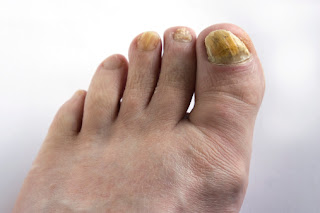Nail fungus is a common condition that affects millions of people worldwide, causing discomfort, embarrassment, and a decrease in the overall health and appearance of the nails. But fear not! In this article, we will explore the causes, symptoms, and most importantly, the treatment options for nail fungus, so you can regain healthy, beautiful nails once again.
Understanding Nail Fungus (Onychomycosis)
Nail fungus, or onychomycosis, is a type of fungal infection that affects the nails, most commonly the toenails. It is caused by the overgrowth of fungi, usually dermatophytes, which thrive in warm, moist environments, such as inside shoes or socks. The infection can start as a small white or yellow spot under the tip of the nail and gradually spread deeper into the nail, causing discoloration, thickening, and crumbling of the nails. In some cases, the nail may become detached from the nail bed, causing pain and discomfort.
Onychomycosis is a stubborn condition that can be challenging to treat, but with the right approach and consistent care, it can be effectively managed. Let's take a closer look at some of the treatment options available for nail fungus.
Treatment Options for Nail Fungus
1. Topical Antifungal Medications
Topical antifungal medications are available over-the-counter or by prescription and are applied directly to the affected nails. They work by penetrating the nail and killing the fungi. These medications typically come in the form of creams, gels, or nail lacquers, and are easy to apply at home. It's important to follow the instructions for use carefully and be consistent with the application to achieve the best results. Topical antifungal medications are often recommended for mild to moderate cases of nail fungus.
2. Oral Antifungal Medications
Oral antifungal medications are prescribed by a healthcare professional and are taken orally in the form of pills or capsules. These medications work from the inside out, reaching the infected nail through the bloodstream, and are generally more effective for severe cases of nail fungus. They may have potential side effects and interactions with other medications, so it's crucial to follow the prescribed dosage and consult with a healthcare professional before starting oral antifungal treatment.
3. Laser Treatment
Laser treatment is a relatively newer option for nail fungus treatment and involves the use of laser energy to target and destroy the fungi in the nails. The laser energy heats up the nail, killing the fungi without damaging the surrounding healthy tissue. Laser treatment is painless and usually requires multiple sessions for optimal results. It can be a suitable option for those who prefer a non-medication approach or have contraindications to oral antifungal medications.
4. Nail Debridement
Nail debridement is a process of trimming, filing, or removing the infected part of the nail to reduce the thickness and improve the appearance of the nails. It is often done in combination with other treatment options, such as topical or oral antifungal medications, to enhance their effectiveness by reducing the amount of infected nail material that needs to be penetrated by the medication. Nail debridement should be performed by a trained healthcare professional to avoid further damage to the nails or surrounding skin.
5. Proper Nail Care
Proper nail care is an essential part of managing nail fungus and preventing its recurrence. Keeping the nails clean, dry, and trimmed can help reduce the chances of fungal growth. Avoiding tight-fitting shoes and wearing breathable socks made of natural fibers, such as cotton, can also help create a less favorable environment for fungi to thrive. Additionally, avoiding nail trauma, such as picking at the nails or cutting the cuticles, can prevent the entry of fungi into the nails.
6. Home Remedies
There are several home remedies that are commonly suggested for nail fungus treatment, although their effectiveness may vary. Some popular home remedies include soaking the affected nails in a solution of warm water and vinegar, applying tea tree oil, oregano oil, or garlic oil to the nails, or using over-the-counter products, such as Vicks VapoRub or hydrogen peroxide. While these home remedies may show some anecdotal success, it's important to consult with a healthcare professional before relying solely on them as a treatment option for nail fungus.
Prevention Tips
Preventing nail fungus is always better than treating it. Here are some tips to help you reduce the risk of developing nail fungus:
- Keep your nails clean and dry
- Trim your nails regularly, and avoid cutting the cuticles
- Wear breathable socks and shoes
- Avoid sharing nail care tools or shoes with others
- Use antifungal powder or spray in your shoes
- Choose a reputable nail salon that practices proper hygiene
Conclusion
Nail fungus, or onychomycosis, can be a persistent and bothersome condition that affects the health and appearance of the nails. However, with the right treatment approach and proper nail care, it can be effectively managed. Whether you opt for topical or oral antifungal medications, laser treatment, nail debridement, or a combination of these methods, it's important to consult with a healthcare professional to determine the most suitable treatment plan for your specific case. Remember to practice good nail hygiene, and take preventive measures to reduce the risk of nail fungus. Say goodbye to nail fungus and hello to healthy, beautiful nails!
Published on: April 14, 2023
